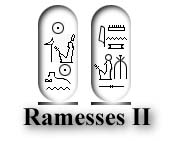 (Usermaatresetepenre)
(Usermaatresetepenre)
1279-1213 B.C.
19th Dynasty
The son of Seti I and Queen Tuya was the third king of the 19th Dynasty. Called Ramesses
the Great, he lived to be 96 years old, had 200 wives and concubines, 96 sons and 60
daughters. One son, Prince Kha-m-was, was a high priest of Ptah, governor of Memphis, and
was in charge of the restoration of the Pyramid of Unas. This son was buried in The
Serapeum. Ramesses II outlived the first thirteen of his heirs. Ramesses was named co-ruler
with his father, Seti I, early in his life. He accompanied his father on numerous campaigns in
Libya and Nubia. At the age of 22 Ramesses went on a campaign in Nubia with two of his
own sons. Seti I and Ramesses built a palace in Avaris where Ramesses I had started a new
capital. When Seti I died in 1290 B.C., Ramesses assumed the throne and began a series of
wars against the Syrians. The famous Battle of Kadesh is inscribed on the walls of Ramesses
temple.
Ramesses' building accomplishments are two temples at Abu Simbel, the hypostyle hall at
Karnak, a mortuary complex at Abydos, the Colossus of Ramesses at Memphis, a vast tomb
at Thebes, additions at the Luxor Temple, and the famous Ramesseum. Among Ramesses'
wives were Nefertari, Queen Istnofret, his two daughters, Binthanath and Merytamon, and the
Hittite princess, Maathornefrure. Ramesses was originally buried in the Valley of the Kings.
Because of the widespread looting of tombs during the 21st Dynasty the priests removed
Ramesses body and took it to a holding area where the valuable materials such, as gold-leaf
and semi-precious inlays, were removed. The body was then rewrapped and taken to the
tomb of an 18th Dynasty queen, Inhapi. The bodies of Ramesses I and Seti I were done in
like fashion and all ended up at the same place. Amenhotep I's body had been placed there as
well at an earlier time. Seventy-two hours later, all of the bodies were again moved, this time
to the Royal Cache that was inside the tomb of High Priest Pinudjem II. The priests
documented all of this on the linen that covered the bodies. This “systematic” looting by the
priests was done in the guise of protecting the bodies from the "common" thieves.





